Related Research Articles

Photonics is a branch of optics that involves the application of generation, detection, and manipulation of light in form of photons through emission, transmission, modulation, signal processing, switching, amplification, and sensing. Photonics is closely related to quantum electronics, where quantum electronics deals with the theoretical part of it while photonics deal with its engineering applications. Though covering all light's technical applications over the whole spectrum, most photonic applications are in the range of visible and near-infrared light. The term photonics developed as an outgrowth of the first practical semiconductor light emitters invented in the early 1960s and optical fibers developed in the 1970s.
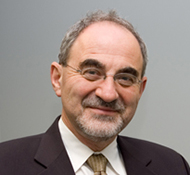
Eli Yablonovitch is an American physicist and engineer who, along with Sajeev John, founded the field of photonic crystals in 1987. He and his team were the first to create a 3-dimensional structure that exhibited a full photonic bandgap, which has been named Yablonovite. In addition to pioneering photonic crystals, he was the first to recognize that a strained quantum-well laser has a significantly reduced threshold current compared to its unstrained counterpart. This is now employed in the majority of semiconductor lasers fabricated throughout the world. His seminal paper reporting inhibited spontaneous emission in photonic crystals is among the most highly cited papers in physics and engineering.
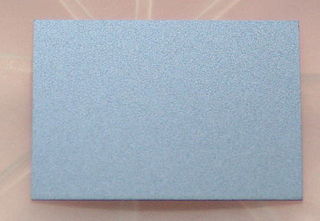
Indium phosphide (InP) is a binary semiconductor composed of indium and phosphorus. It has a face-centered cubic ("zincblende") crystal structure, identical to that of GaAs and most of the III-V semiconductors.

Photodetectors, also called photosensors, are sensors of light or other electromagnetic radiation. There are a wide variety of photodetectors which may be classified by mechanism of detection, such as photoelectric or photochemical effects, or by various performance metrics, such as spectral response. Semiconductor-based photodetectors typically use a p–n junction that converts photons into charge. The absorbed photons make electron–hole pairs in the depletion region. Photodiodes and photo transistors are a few examples of photo detectors. Solar cells convert some of the light energy absorbed into electrical energy.
Indium gallium arsenide (InGaAs) is a ternary alloy of indium arsenide (InAs) and gallium arsenide (GaAs). Indium and gallium are group III elements of the periodic table while arsenic is a group V element. Alloys made of these chemical groups are referred to as "III-V" compounds. InGaAs has properties intermediate between those of GaAs and InAs. InGaAs is a room-temperature semiconductor with applications in electronics and photonics.
A photonic integrated circuit (PIC) or integrated optical circuit is a microchip containing two or more photonic components that form a functioning circuit. This technology detects, generates, transports, and processes light. Photonic integrated circuits utilize photons as opposed to electrons that are utilized by electronic integrated circuits. The major difference between the two is that a photonic integrated circuit provides functions for information signals imposed on optical wavelengths typically in the visible spectrum or near infrared (850–1650 nm).
A hybrid silicon laser is a semiconductor laser fabricated from both silicon and group III-V semiconductor materials. The hybrid silicon laser was developed to address the lack of a silicon laser to enable fabrication of low-cost, mass-producible silicon optical devices. The hybrid approach takes advantage of the light-emitting properties of III-V semiconductor materials combined with the process maturity of silicon to fabricate electrically driven lasers on a silicon wafer that can be integrated with other silicon photonic devices.
Silicon photonics is the study and application of photonic systems which use silicon as an optical medium. The silicon is usually patterned with sub-micrometre precision, into microphotonic components. These operate in the infrared, most commonly at the 1.55 micrometre wavelength used by most fiber optic telecommunication systems. The silicon typically lies on top of a layer of silica in what is known as silicon on insulator (SOI).

Fiber-optic communication is a method of transmitting information from one place to another by sending pulses of infrared or visible light through an optical fiber. The light is a form of carrier wave that is modulated to carry information. Fiber is preferred over electrical cabling when high bandwidth, long distance, or immunity to electromagnetic interference is required. This type of communication can transmit voice, video, and telemetry through local area networks or across long distances.
Milton Feng co-created the first transistor laser, working with Nick Holonyak in 2004. The paper discussing their work was voted in 2006 as one of the five most important papers published by the American Institute of Physics since its founding 75 years ago. In addition to the invention of transistor laser, he is also well known for inventions of other "major breakthrough" devices, including the world's fastest transistor and light-emitting transistor (LET). As of May, 2009 he is a professor at the University of Illinois at Urbana–Champaign and holds the Nick Holonyak Jr. Endowed Chair Professorship.
Michal Lipson is an American physicist known for her work on silicon photonics. A member of the National Academy of Sciences since 2019, Lipson was named a 2010 MacArthur Fellow for contributions to silicon photonics especially towards enabling GHz silicon active devices. Until 2014, she was the Given Foundation Professor of Engineering at Cornell University in the school of electrical and computer engineering and a member of the Kavli Institute for Nanoscience at Cornell. She is now the Eugene Higgins Professor of Electrical Engineering at Columbia University. In 2009 she co-founded the company PicoLuz, which develops and commercializes silicon nanophotonics technologies. In 2019, she co-founded Voyant Photonics, which develops next generation lidar technology based on silicon photonics. In 2020 Lipson was elected the 2021 vice president of Optica, and serves as the Optica president in 2023.
Ilesanmi Adesida is a Nigerian American physicist of Yoruba descent. He has been the provost at Nazarbayev University in Astana, Kazakhstan, from September 2016.
Demetri Psaltis is a Greek-American electrical engineer who was the Dean of the School of Engineering at École Polytechnique Fédérale de Lausanne from 2007 to 2017. Since 2024 he is a professor emeritus at EPFL. He is one of the founders of the term and the field of optofluidics. He is also well known for his past work in holography, especially with regards to optical computing, holographic data storage, and neural networks. He is an author of over 1100 publications, contributed more than 20 book chapters, invented more than 50 patents, and currently has a h-index of 104.
Transistor laser is a semiconductor device that functions as a transistor with an electrical output and an optical output, as opposed to the typical two electrical outputs. This optical output separates it from typical transistors and, because optical signals travel faster than electrical signals, has the potential to speed up computing immensely. Researchers who discovered the transistor laser developed a new model of Kirchhoff's current law to better model the behavior of simultaneous optical and electrical output.
Indium gallium arsenide phosphide is a quaternary compound semiconductor material, an alloy of gallium arsenide, gallium phosphide, indium arsenide, or indium phosphide. This compound has applications in photonic devices, due to the ability to tailor its band gap via changes in the alloy mole ratios, x and y.
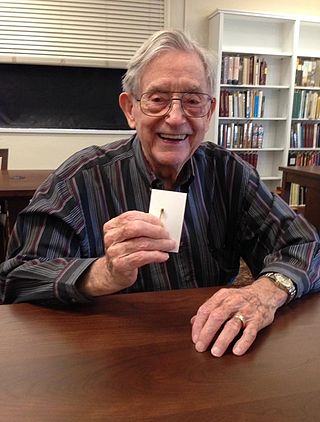
James Robert Biard was an American electrical engineer and inventor who held 73 U.S. patents. Some of his more significant patents include the first infrared light-emitting diode (LED), the optical isolator, Schottky clamped logic circuits, silicon Metal Oxide Semiconductor Read Only Memory, a low bulk leakage current avalanche photodetector, and fiber-optic data links. In 1980, Biard became a member of the staff of Texas A&M University as an Adjunct Professor of Electrical Engineering. In 1991, he was elected as a member into the National Academy of Engineering for contributions to semiconductor light-emitting diodes and lasers, Schotky-clamped logic, and read-only memories.
James J. Coleman is an electrical engineer who worked at Bell Labs, Rockwell International, and the University of Illinois, Urbana. He is best known for his work on semiconductor lasers, materials and devices including strained-layer indium gallium arsenide lasers and selective area epitaxy. Coleman is a Fellow of the IEEE and a member of the US National Academy of Engineering.
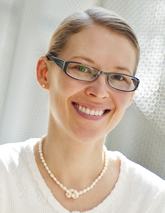
Alexandra Boltasseva is Ron And Dotty Garvin Tonjes Distinguished Professor of electrical and computer engineering at Purdue University, and editor-in-chief for The Optical Society's Optical Materials Express journal. Her research focuses on plasmonic metamaterials, manmade composites of metals that use surface plasmons to achieve optical properties not seen in nature.

John E. Bowers is an American physicist, engineer, researcher and educator. He holds the Fred Kavli Chair in Nanotechnology, the director of the Institute for Energy Efficiency and a distinguished professor in the Departments of Electrical and Computer Engineering and Materials at University of California, Santa Barbara. He was the deputy director of American Institute of Manufacturing of Integrated Photonics from 2015 to 2022.
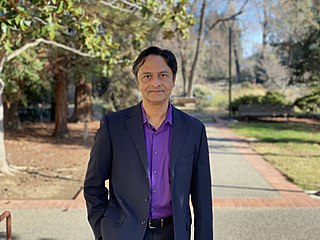
M. Saif Islam is a Bangladeshi-American engineering professor of Electrical and Computer Engineering at the University of California, Davis.
References
- 1 2 "Silicon-Indium-Gallium-Arsenide Avalanche Photodetectors". University of California, Santa Barbara. Retrieved October 31, 2019.
- ↑ "book website for Aaron Hawkins" . Retrieved October 31, 2019.
- 1 2 "Aaron Hawkins faculty profile page". Brigham Young University. Retrieved October 30, 2019.
- 1 2 "About Dr. Hawkins". Aaron Hawkins' homepage. Retrieved October 31, 2019.
- 1 2 Engineering Achievement Award, IEEE Photonics Society. Accessed October 31, 2019.
- 1 2 "Spotlight: Aaron R. Hawkins" (PDF). IEEE Photonics Society Newsletter. 28 (4): 16. August 2014.
- 1 2 Hollingshead, Todd (March 6, 2019). "Secret to lab-on-a-chip breakthrough: Matte black nail polish". TechXplore. Retrieved October 31, 2019.
- ↑ MacDonald, Cara (June 29, 2019). "BYU to provide NASA with critical research for future human missions to Mars". KSL.com . Retrieved October 31, 2019.
- ↑ "Professors Hawkins and Schultz publish new ECEn book". BYU Electrical and Computer Engineering. July 20, 2018. Retrieved October 31, 2019.
- ↑ Dragoman, Mircea (May 3, 2018). "Handbook of Optofluidics (review)". Optics & Photonics News. Optica. Retrieved June 19, 2023.
- ↑ "The Year Money Grew on Trees (review)". Publishers Weekly. Retrieved October 31, 2019.
- ↑ Frade, Pat (2010). "The Year Money Grew on Trees (review)". Children's Book and Media Review. 31 (2). Article 23.
- ↑ "2015 OSA Fellows". The Optical Society.
- ↑ "Fellows Directory". IEEE.
- ↑ "Dr. Hawkins made IEEE Fellow". Electrical and Computer Engineering. Brigham Young University. October 14, 2015. Retrieved October 30, 2019.